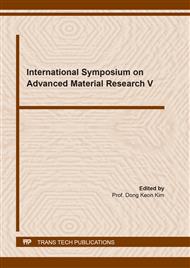[1]
D.K. Singh, S. Kumar, G. Udayabhanu, R.P. John, 4(N, N-dimethylamino) Benzaldehyde nicotinic hydrazone as corrosion inhibitor for mild steel in 1M HCl solution: An experimental and theoretical study, J. Mol. Liqs.216 (2016) 738 – 746.
DOI: 10.1016/j.molliq.2016.02.012
Google Scholar
[2]
M.V. Fiori-Bimbi, P.E. Alvarez, H. Vaca, C.A. Gervasi, Corrosion Inhibition of mild steel in HCl solution by pectin, Corros. Sci. 92 (2015) 192 – 199.
DOI: 10.1016/j.corsci.2014.12.002
Google Scholar
[3]
Yadav, M., Behera, D., & Sharma, U., (2016). Nontoxic Corrosion Inhibitors for N80 Steel in Hydrochloric Acid, Arabian J. Chem. 9(2) (2010) S1487 – S1495.
DOI: 10.1016/j.arabjc.2012.03.011
Google Scholar
[4]
J. Zhao, N. Zhang, C. Qu, X. Wu, J. Zhang, X. Zhang, Cigarette butts and their application in corrosion inhibition for N80 steel at 90 °C in a hydrochloric acid solution. Industrial and Engineering Chemistry Research, 49, 3986 – 3991.
DOI: 10.1021/ie100168s
Google Scholar
[5]
F.U. Renner, A. Stierl, H. Dosch, D.M. Kolb, T.L. Lee, J. Zegenhagen, Initial corrosion observed on the atomic scale. Nature, 439 (2006) 707 – 710.
DOI: 10.1038/nature04465
Google Scholar
[6]
N.P. Branko, Chapter 14 - Corrosion Inhibitors, in Corrosion Engineering, Principles and Solved Problems, 2015, pp.581-597. https://doi.org/10.1016/B978-0-444-62722-3.00014-8.
Google Scholar
[7]
P. Roy, P. Karfa, U. Adhikari, D. Sukul, Corrosion inhibition of mild steel in acidic medium by polyacrylamide grafted guar gum with various grafting percentage: Effect of intramolecular synergism, Corros. Sci. 88 (2014) 246 – 253.
DOI: 10.1016/j.corsci.2014.07.039
Google Scholar
[8]
N.O. Obi-Egbedi, I.B. Obot, Inhibitive properties, thermodynamic and quantum chemical studies of alloxazine on mild steel corrosion in H2SO4, Corros. Sci. 53 (2011) 263 – 275.
DOI: 10.1016/j.corsci.2010.09.020
Google Scholar
[9]
S.K. Shukla, M.A. Quraishi, The effects of pharmaceutically active compound doxycycline on the corrosion of mild steel in hydrochloric acid solution. Corros. Sci. 52 (2010) 314 – 321.
DOI: 10.1016/j.corsci.2009.09.017
Google Scholar
[10]
G. Gece, Drugs: A review of promising novel corrosion inhibitors, Corros. Sci. 53 (2011) 3873 – 3898.
DOI: 10.1016/j.corsci.2011.08.006
Google Scholar
[11]
M. Chevalier, F. Robert, N. Amusant, M. Traisnel, C. Roos, M. Lebrini, Enhanced corrosion resistance of mild steel in 1m hydrochloric acid solution by alkaloids extract from aniba rosaeodora plant: Electrochmical, phytochemical and xps studies, Electrochim. Acta, 131 (2014) 96 – 105.
DOI: 10.1016/j.electacta.2013.12.023
Google Scholar
[12]
M.A.J. Mazumder, H.A. Al-Muallem, M. Faiz, S.A. Ali, Design and synthesis of a novel class of inhibitors for mild steel corrosion in acidic and carbon dioxide- saturated saline media, Corros. Sci. 87 (2014) 187 – 198.
DOI: 10.1016/j.corsci.2014.06.026
Google Scholar
[13]
B.E. Brycki, I.H. Kowalczyk, A. Szulc, O. Kaczerewska, M. Pakiet, Organic Corrosion Inhibitors, IntechOpen, 2017. http://doi.org/10.5772/intechopen.72943.
DOI: 10.5772/intechopen.72943
Google Scholar
[14]
Y. Li, P. Zhao, Q. Liang, B. Hou, Berberine as a natural source inhibitor for mild steel in 1 M H2SO4. Appl. Surf. Sci. 252 (2005) 1245-1253.
DOI: 10.1016/j.apsusc.2005.02.094
Google Scholar
[15]
G. Quartarone, L. Ronchin, A. Vavasori, C. Tortato, L. Bonaldo, Inhibitive action of gramine towards corrosion of mild steel in deaerated 1.0 M hydrochloric acid solutions, Corros. Sci. 64 (2012) 82-89.
DOI: 10.1016/j.corsci.2012.07.008
Google Scholar
[16]
H. Ashassi-Sorkhabi, M.R. Majidi, Seyyedi. Investigation of inhibition effect of some amino acids against steel corrosion in HCl solution, Appl. Surf. Sci. 225 (2004) 176-185.
DOI: 10.1016/j.apsusc.2003.10.007
Google Scholar
[17]
M. ÖZcan, AC impedance measurements of cysteine adsorption at mild steel/sulphuric acid interface as corrosion inhibitor, J Solid. State Electr. 12 (2008) 1653-1661.
DOI: 10.1007/s10008-008-0551-1
Google Scholar
[18]
R.T. Loto, Anti-corrosion performance of the synergistic properties of benzenecarbonitrile and 5-bromovanillin on 1018 carbon steel in HCl environment, Sci. Reps. 7(1) (2017) 17555.
DOI: 10.1038/s41598-017-17867-0
Google Scholar
[19]
R.T. Loto, O. Tobilola, O. Corrosion inhibition properties of the synergistic effect of 4-hydroxy-3-methoxybenzaldehyde and hexadecyltrimethylammoniumbromide on mild steel in dilute acid solutions, J. King Saud Univ. Eng. Sci. 30(4) (2018) 384-390.
DOI: 10.1016/j.jksues.2016.10.001
Google Scholar
[20]
R.T. Loto, C.A. Loto, Effect of P-phenylediamine on the corrosion of austenitic stainless steel type 304 in hydrochloric acid, Int. J. Elect. Sci. 7(10) (2012) 9423-9440.
DOI: 10.1007/s12633-015-9344-1
Google Scholar
[21]
R.T. Loto, E. Oghenerukewe, Inhibition studies of rosmarinus officinalis on the pitting corrosion resistance 439LL ferritic stainless steel in dilute sulphuric acid, Orient. J. Chem. 32(5) (2016) 2813-2832.
DOI: 10.13005/ojc/320557
Google Scholar
[22]
A. Bouoidina, M. Chaouch, A. Abdellaoui, A. Lahkimi, B. Hammouti, F. El-Hajjaji, M. Taleb, A. Nahle, Essential oil of Foeniculum vulgare,: antioxidant and corrosion inhibitor on mild steel immersed in hydrochloric medium, Anti-Corros. Method M. 64(5), 563-572.
DOI: 10.1108/acmm-10-2016-1716
Google Scholar
[23]
I. Hamdani, E. El Ouariachi, O. Mokhtari, A. Salhi, N. Chahboun, B. ElMahi, A. Bouyanzer, A. Zarrouk, B. Hammouti, J. Costa, Chemical constituents and corrosion inhibition of mild steel by the essential oil of Thymus algeriensis in 1.0 M hydrochloric acid solution, Der Pharm. Chem. 7(8) (2015) 252-264.
DOI: 10.1007/s11164-013-1246-5
Google Scholar
[24]
Y. El Ouadi, A. Bouyanzer, L. Majidi, J. Paolini, J.M. Desjobert, J. Costa, A. Chetouani, B. Hammouti, Salvia officinalis essential oil and the extract as green corrosion inhibitor of mild steel in hydrochloric acid, J. Chem. Pharm. Res. 6(7) (2014) 1401-1416.
DOI: 10.1007/s11164-014-1802-7
Google Scholar
[25]
C.A. Loto, R.T. Loto, A.P.I. Popoola, Effect of neem leaf (azadirachita indica) extract on the corrosion inhibition of mild steel in dilute acids, Int. J. Phy. Sci. 6(9) (2011) 2249-2257.
DOI: 10.17159/0379-4350/2015/v68a16
Google Scholar
[26]
R.T. Loto, E. Oghenerukewe, Inhibition studies of Rosmarinus officinalis on the pitting corrosion resistance 439LL ferritic stainless steel in dilute sulphuric acid, Orient. J. Chem. 32(2) (2016) 2813-2832.
DOI: 10.13005/ojc/320557
Google Scholar
[27]
K. Boumhara, M. Tabyaoui, C. Jama, F. Bentiss, Artemisia Mesatlantica essential oil as green inhibitor for carbon steel corrosion in 1 M HCl solution: Electrochemical and XPS investigations, J. Ind. Eng. Chem. 29(2015) 146-155.
DOI: 10.1016/j.jiec.2015.03.028
Google Scholar
[28]
N. Lahhit, A. Bouyanzer, J-M. Desjobert, B. Hammouti, R. Salghi, J. Costa, C. Jama, F. Bentiss, L. Majidi, Fennel (Foeniculum Vulgare) essential oil as green corrosion inhibitor of carbon steel in hydrochloric acid solution, Port. Electrochim. Acta, 29(2) (2011) 127-138.
DOI: 10.4152/pea.201102127
Google Scholar


